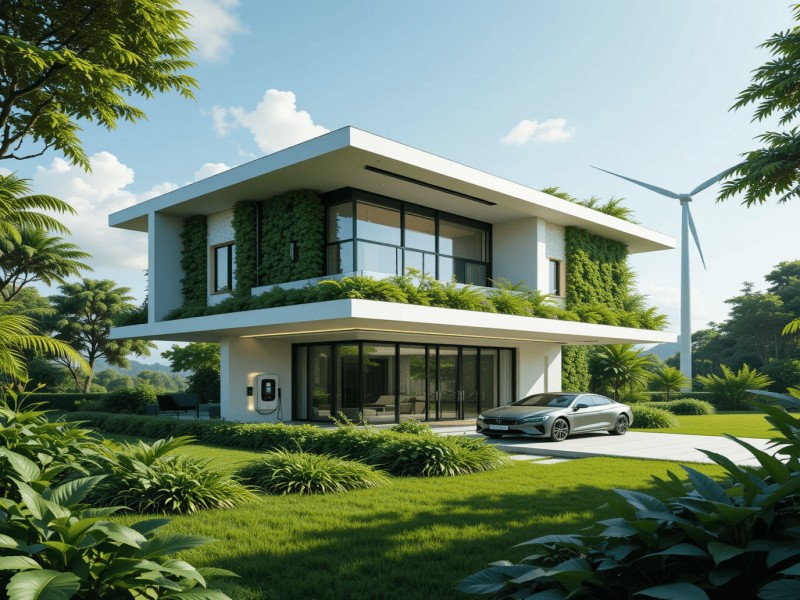
Real Estate 2025: Where Smart Tech Meets Sustainable Living?
Luxury residential property, especially a property priced more than 4 crore, is setting up a new benchmark in the real estate market in India. In the previous four months, the sales of luxury homes recorded hike of 28% compared to 2024. A person with high net worth (HNIS) and NRIS are the major motivational power behind this growth. These buyers are looking for houses with smart technology, sustainable design, and premium features such as private spas, wellness centers and infinity pools.
Mumbai: Luxury center

Areas such as Bandra, Worli, Lower Parel, and Thane remain the first choice for HNIS. In 2024, 21 ultra-linguistic properties worth more than 40 crore were sold in Mumbai, which had a total value of 2,200 crore. The expansion of Mumbai Metro and better connectivity in suburban areas like Navi Mumbai has further increased property prices in these areas. Buyers are now attracted to low-density apartments and branded residences such as Ritz-Carlton, which provide international architecture and design.
Delhi-NCR: global attraction
Delhi-NCR, especially Gurugram's Golf Course Road, Noida, and Dwarka Expressway, is another major destination for luxury houses. lGurugram's world -class infrastructure and closeness with corporate hubs make it attractive to rich buyers. Buyers are demanding large, greenery houses and smart home automation, which complement modern lifestyle.
Bengaluru: Tech and Luxury's confluence
Bangalore's real estate market is growing rapidly due to a technical economy and global lifestyle. The demand for luxury apartments has crossed 1,000 crore this year, especially areas like Sarjapur Road, Indiranagar and Whitefield. Bengaluru is one of the fastest growing luxury markets in the world. Projects with eco-friendly houses, such as solar panels and rainwater harvesting systems are attracting buyers here.
Affordable city: middle class dream

For affordable housing, Tier-2 & 3 are emerging stars this year. Low land prices, better connectivity, and government schemes such as Pradhan Mantri Awas Yojana (PMAY) make these cities attractive for home buyers and investors for the first time. These cities provide the possibility of large carpet region and high price increase.
Ahmedabad: New center of development
Ahmedabad, especially SG Highway and Gift City, are the top choice for affordable and high -returns investment. Metro connectivity and growing economy have brought the city to the radar of global investors. The price of 2-3 BHK apartments is between 30-60 lakhs, which makes it accessible to the middle class.
Jaipur: Cultural and Economic Sangam
Jaipur, especially New Town and Rajarhat, is an emerging center for affordable homes. The development of IT and commercial hubs, as well as infrastructure such as Jaipur Metro, makes the city attractive to investors. The price of residential units here is between 25-50 lakhs.
Lucknow: City of opportunities
Lucknow, especially Gomti Nagar and Hazratganj, are attracting investors due to opportunities for strong social infrastructure and startups. 2-3 bhk houses are available at a price of 20-45 lakh, which makes it economical and beneficial.
Investment possibilities

Tier-2 cities like Ahmedabad and Jaipur are expected to increase an annual price increase of 8–12%, which is more than metros. Government policies like tax exemption and low stamp duty make these cities more attractive.
Emerging Warehouse: Future of e-commerce and logistics
The increasing demand for e-commerce and hybrid work models has brought the warehousing and logistics sector to new heights. An additional demand of 15-18 million square feet for data centers by 2025 is estimated.
Delhi-NCR: Logistics stronghold
Areas such as Gurugram, Noida, and Greater Noida are the top choice for warehousing due to excellent connectivity through the major consumption markets and expressways. In 2024, Delhi-NCR took part of 32% of the land deals.
Mumbai: Benefits of ports
Areas such as Bhiwandi and Panvel are attracting investors due to the proximity of the ports of Mumbai and the demand for e-commerce. Mumbai contributed to 12% of land deals in 2024.
Bengaluru: Tech and Logistics combination
Areas such as Hosur Road and Devanhalli are ideal for warehousing due to Bangalore's tech-centered economy. The availability of flexible office space in the city further increases this demand.
Investment possibilities
The warehousing sector offers a 7-10% rental yield, which has been increased by the demand of e-commerce giants such as Amazon and Flipkart. Government policies promoting RERA transparency and logistics infrastructure further strengthens the region.
Major trends of 2025

Durability: Green buildings, which are estimated to reach $ 39 billion by 2025, are in demand in both residential and commercial areas.
Smart Technology: AI-based property search, transparent transactions through blockchain, and virtual reality tour markets.
Infrastructure: Metro expansion, expressway, and smart city mission projects are increasing property prices. Affordable policies: The RBI will increase the power of home loans due to the interest rate deduction of 50 basis points in 2025.
Where to invest?
- For luxury homes: Mumbai (Bandra, Worli), Delhi-NCR (Gurugram), and Bengaluru (Whitefield).
- For Warehouse: Delhi-NCR, Mumbai, and Bengaluru.
- India's real estate market in 2025 is a treasure of opportunities for investors. By selecting the right location and trends, you can not only make financial advantage, but also create a strong base for the future.
